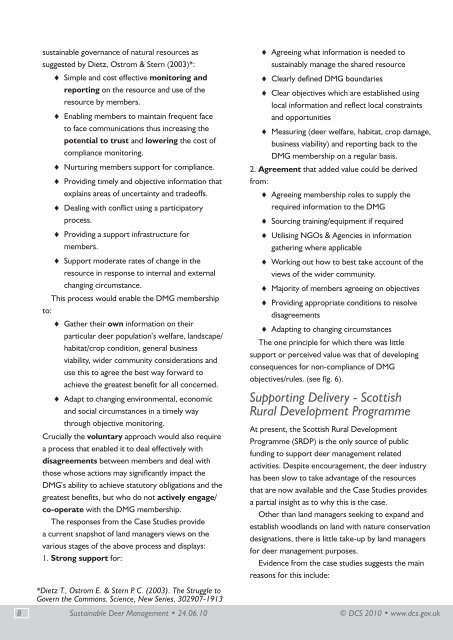Sustainable Deer Management A Case Study Report for the Deer ...
Sustainable Deer Management A Case Study Report for the Deer ...
Sustainable Deer Management A Case Study Report for the Deer ...
Create successful ePaper yourself
Turn your PDF publications into a flip-book with our unique Google optimized e-Paper software.
sustainable governance of natural resources as<br />
suggested by Dietz, Ostrom & Stern (2003)*:<br />
to:<br />
♦♦<br />
Simple and cost effective monitoring and<br />
reporting on <strong>the</strong> resource and use of <strong>the</strong><br />
resource by members.<br />
♦ ♦ Enabling members to maintain frequent face<br />
to face communications thus increasing <strong>the</strong><br />
potential to trust and lowering <strong>the</strong> cost of<br />
compliance monitoring.<br />
♦ ♦ Nurturing members support <strong>for</strong> compliance.<br />
♦ ♦ Providing timely and objective in<strong>for</strong>mation that<br />
explains areas of uncertainty and tradeoffs.<br />
♦ ♦ Dealing with conflict using a participatory<br />
process.<br />
♦ ♦ Providing a support infrastructure <strong>for</strong><br />
members.<br />
♦ ♦ Support moderate rates of change in <strong>the</strong><br />
resource in response to internal and external<br />
changing circumstance.<br />
This process would enable <strong>the</strong> DMG membership<br />
♦♦<br />
Ga<strong>the</strong>r <strong>the</strong>ir own in<strong>for</strong>mation on <strong>the</strong>ir<br />
particular deer population’s welfare, landscape/<br />
habitat/crop condition, general business<br />
viability, wider community considerations and<br />
use this to agree <strong>the</strong> best way <strong>for</strong>ward to<br />
achieve <strong>the</strong> greatest benefit <strong>for</strong> all concerned.<br />
♦♦<br />
Adapt to changing environmental, economic<br />
and social circumstances in a timely way<br />
through objective monitoring.<br />
Crucially <strong>the</strong> voluntary approach would also require<br />
a process that enabled it to deal effectively with<br />
disagreements between members and deal with<br />
those whose actions may significantly impact <strong>the</strong><br />
DMG’s ability to achieve statutory obligations and <strong>the</strong><br />
greatest benefits, but who do not actively engage/<br />
co-operate with <strong>the</strong> DMG membership.<br />
The responses from <strong>the</strong> <strong>Case</strong> Studies provide<br />
a current snapshot of land managers views on <strong>the</strong><br />
various stages of <strong>the</strong> above process and displays:<br />
1. Strong support <strong>for</strong>:<br />
♦♦<br />
Agreeing what in<strong>for</strong>mation is needed to<br />
sustainably manage <strong>the</strong> shared resource<br />
♦♦<br />
Clearly defined DMG boundaries<br />
♦♦<br />
Clear objectives which are established using<br />
local in<strong>for</strong>mation and reflect local constraints<br />
and opportunities<br />
♦♦<br />
Measuring (deer welfare, habitat, crop damage,<br />
business viability) and reporting back to <strong>the</strong><br />
DMG membership on a regular basis.<br />
2. Agreement that added value could be derived<br />
from:<br />
♦♦<br />
Agreeing membership roles to supply <strong>the</strong><br />
required in<strong>for</strong>mation to <strong>the</strong> DMG<br />
♦♦<br />
Sourcing training/equipment if required<br />
♦♦<br />
Utilising NGOs & Agencies in in<strong>for</strong>mation<br />
ga<strong>the</strong>ring where applicable<br />
♦♦<br />
Working out how to best take account of <strong>the</strong><br />
views of <strong>the</strong> wider community.<br />
♦♦<br />
Majority of members agreeing on objectives<br />
♦♦<br />
Providing appropriate conditions to resolve<br />
disagreements<br />
♦♦<br />
Adapting to changing circumstances<br />
The one principle <strong>for</strong> which <strong>the</strong>re was little<br />
support or perceived value was that of developing<br />
consequences <strong>for</strong> non-compliance of DMG<br />
objectives/rules. (see fig. 6).<br />
Supporting Delivery - Scottish<br />
Rural Development Programme<br />
At present, <strong>the</strong> Scottish Rural Development<br />
Programme (SRDP) is <strong>the</strong> only source of public<br />
funding to support deer management related<br />
activities. Despite encouragement, <strong>the</strong> deer industry<br />
has been slow to take advantage of <strong>the</strong> resources<br />
that are now available and <strong>the</strong> <strong>Case</strong> Studies provides<br />
a partial insight as to why this is <strong>the</strong> case.<br />
O<strong>the</strong>r than land managers seeking to expand and<br />
establish woodlands on land with nature conservation<br />
designations, <strong>the</strong>re is little take-up by land managers<br />
<strong>for</strong> deer management purposes.<br />
Evidence from <strong>the</strong> case studies suggests <strong>the</strong> main<br />
reasons <strong>for</strong> this include:<br />
*Dietz T., Ostrom E. & Stern P. C. (2003). The Struggle to<br />
Govern <strong>the</strong> Commons. Science, New Series, 302907-1913<br />
8 <strong>Sustainable</strong> <strong>Deer</strong> <strong>Management</strong> • 24.06.10 © DCS 2010 • www.dcs.gov.uk
















